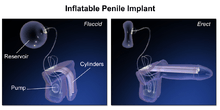Penile implant

Penile implants are urological surgical procedures, primarily for the treatment of erectile dysfunction and Peyronie's disease (scar tissue buildup within the penis) as opposed to enlargement as is commonly believed. Although there are many distinct types of implants, most fall into one of two categories: malleable and inflatable.[1]
Malleable penile prosthesis
The malleable penile prosthesis is a set of rods implanted into the corpora of the penis. The rods are hard, but are 'malleable' in the sense that they can be adjusted manually into the erect position.[2]
Inflatable penile implant
The inflatable penile implant, more recently developed, uses a pump system. Saline from a small reservoir, implanted in the lower abdomen, is moved by manual pressure on a small pump, located, with the relief valve, in the scrotum. The saline is pumped into bilateral chambers implanted in the shaft of the penis, which replace the non- or minimally-functioning erectile tissue. This produces an erection. The glans of the penis, however, remains unaffected. 90–95% of inflatable prostheses produce erections suitable for sexual intercourse. In the United States, the inflateable prothesis has largely replaced (in new cases) the malleable one.
References
- ↑ Perito, Paul. "Penile Implants". PeritoUrology.com. Perito Urology. Retrieved 18 November 2014.
- ↑ Perito, Paul. "Malleable Penile Implant Prosthesis". PeritoUrology.com. Perito Urology. Retrieved 18 November 2014.